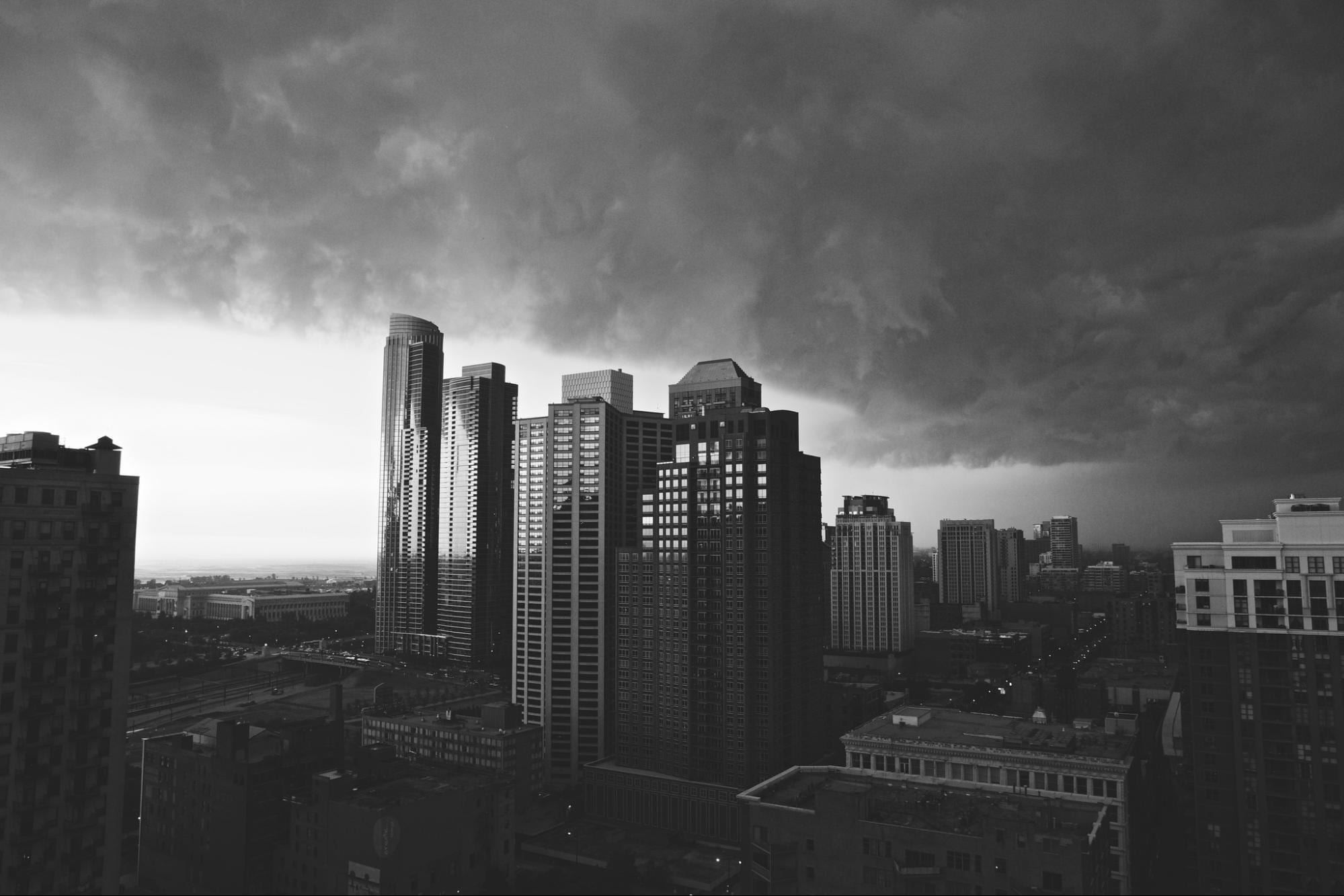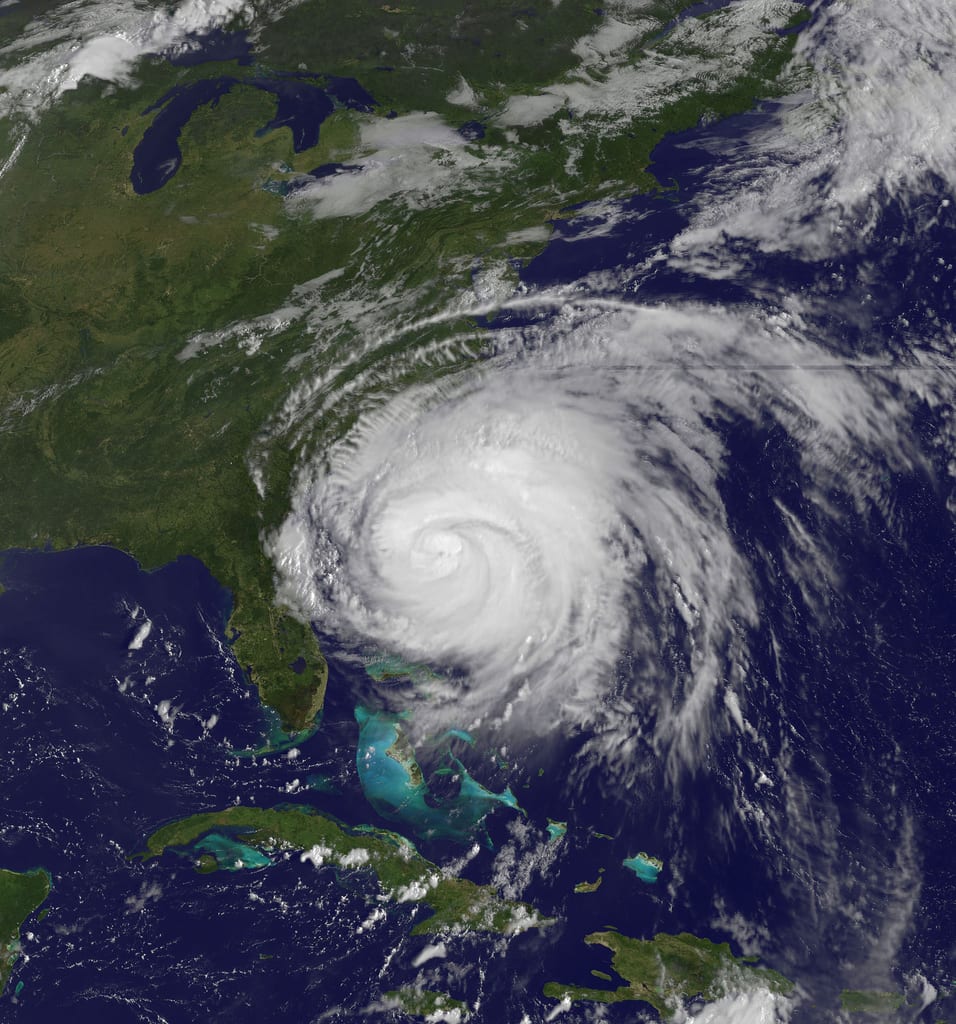In the new movie San Andreas (2015), Dwayne “The Rock†Johnson plays a rescue pilot during an earthquake that destroys San Francisco. Despite the fact that his acting in this movie was less convincing than his role as the humanoid-arachnid thing in the Mummy Returns, Mr. Rock redeems himself by using his wit and insane deltoids to save people with his helicopter.
Hollywood has unleashed killer natural disasters in the past with movies like The Perfect Storm (2000) which featured a deadly trifecta of storms, including a hurricane. And in 1996, Twister sucked us in with its onslaught of tornadoes of ever-increasing intensity.
In the movie The Day after Tomorrow (2001), Hollywood hit earth with everything but the kitchen sink when global-warming triggered a complete destabilization of earth's climate and led to several storms, three bone-chilling hurricanes, floods, and plunged the earth into an ice age.

A complete and sudden destabilization of earth's climate due to increasing temperatures in The Day After Tomorrow is likely just Hollywood fiction. In reality though, meteorological research shows that climate change is indeed changing the way storms behave. Scientists predict that global temperatures will indeed rise in coming decades due to human activities—about 0.35 ℉ per every ten years [1]. Could this seemingly small amount of warming in our atmosphere be enough to create conditions for deadly superstorms?
Meteorological research shows that climate change is indeed changing the way storms behave
Here, we'll explore realistic threats from natural disasters and how they are expected shift with climate change. I'll focus on the two you're likely to encounter in the Southeastern US: tornados and hurricanes. The disasters we'll explore aren't exactly apocalyptic, but they can be quite destructive, and they happen all the time with powerful impacts.
Hurricanes
A tropical cyclone is a spiral of thunderstorms with a low pressure center accompanied by heavy wind and rain. Tropical cyclones affect both the North Atlantic/Gulf of Mexico region (where we call them hurricanes), and the North Pacific Ocean (where we call them typhoons).
Hurricanes and typhoons are most active during the late summer months when warm ocean temperatures are an important factor fueling hurricane formation. Although hurricanes are relatively rare compared to, say, one of our summer thunderstorms, their effects can be enormous.

Hurricane Katrina struck New Orleans in 2005, leading to over 1,800 deaths, not to mention the considerable economic damage it caused [2]. And there have been even deadlier hurricanes in the Atlantic, but none that compare to the 1780 San Calixto Hurricane, which resulted in 20,000 deaths in Barbados while the American Revolution was underway further north [3]. Even these death tolls don't come even close to the deadliest typhoons in the Indian Ocean.
Some scientists think that climate change will increase the threat posed by hurricanes
So what do scientists say about the future of hurricanes as climate change causes temperatures to increase? Some scientists think that climate change will increase the threat posed by hurricanes. The idea is that because climate change leads to warmer ocean temperatures, there is more water vapor above oceans to fuel intense convective storms such as hurricanes and typhoons [4]. One study showed that over the past 35 years the number of hurricanes has actually decreased. That sounds like good news, except that while the raw number of hurricanes decreased, the study points out that recent hurricanes are more likely to reach categories 4 and 5 [5], the most intense ratings on the Shaffir–Simpson hurricane wind scale, with wind speeds over 130 miles per hour.
It's important to note that more intense hurricanes don't always equate to deadlier hurricanes. In fact, the deadliest tropical cyclone was equivalent to only a category 3. Known as the Bhola cyclone, in 1970 it devastated Bangladesh leading to up to 500,000 deaths by some estimates. Although climate change is likely leading to more intense hurricanes, a host of other social factors such as the population density, levee infrastructure, and rescue responses can buffer or worsen a storm's societal impact.
Tornados
Hurricanes and typhoons affect parts of the North Atlantic and Pacific Oceans, respectively. But—like a double cheeseburger with a Diet Coke—tornadoes are primarily an American phenomenon. America is a hotspot for tornado formation, with about 75% of the world's tornadoes forming in the U.S.
Most people are aware that the epicenter for frequent tornadoes is located in Oklahoma, but interestingly, more tornado fatalities actually occur in the southeastern U.S. in Arkansas, Mississippi, Tennessee, and Alabama [6].
Despite having fewer tornadoes than Oklahoma, more tornado-related fatalities actually occur in the southeastern U.S due to a combination of meteorological and social factors (building codes, disaster awareness, and economics) which shift the epicenter of deadly tornadoes 400 miles east from Oklahoma City, OK toward Memphis, TN. In this region, tornadoes often occur at night, and a higher fraction of the population lives in vulnerable mobile homes rather than the more storm-ready homes in Oklahoma which are often built with tornado shelters.

While a single tornado event can be deadly, tornado outbreaks can be even scarier. In a tornado outbreak, a single weather system can spawn multiple tornados. The largest outbreak recorded in North America occurred recently in April 2011 and spawned 200+ tornadoes resulting in 316 deaths, mostly concentrated in Alabama [9].
Will such tornado outbreaks become the norm with climate change? A study published last year by researchers at Florida State University notes that over the past five decades, when tornadoes do occur, they are increasingly occurring in clusters with multiple tornados happening on the same day [10]. So, If super-charged hurricanes weren't bad enough, we'll have more tornados to deal with too.
The Aftermath
Are there any conclusions we can draw about whether we could weather a weather-related disaster? Unfortunately, as long as our climate keeps changing, and storms become more frequent or severe, Earth's weather might start to resemble a kid who has become bored with his game of SimCity and is assaulting it with atmospheric natural disasters.
It is important to keep in mind that we can't blame every single natural disaster on climate change, but research is starting to show that climate change is worsening what is already a deadly problem.
Of course it is important to keep in mind that we can't blame every single natural disaster on climate change, but research is starting to show that climate change is worsening what is already a deadly problem.
Reversing climate change trends is an important long-term step, but once a hurricane or tornado is formed, there isn't much humans can do to stop it. The fact that tornados and hurricanes are much more deadly in areas that don't have the infrastructure to prepare or respond to them is dispiriting. But the flip side of this fact is that social factors can make a difference in saving lives and they are at least possible to control.
Taking appropriate precautionary measures such as raising awareness, improving storm prediction, and investing in storm protection infrastructure can be useful tools to buffer some of the risk associated with super storms.
About the Author
 Jeffery B. Cannon is a doctoral candidate at the University of Georgia researching how disturbances such as wind and fire shape forest ecosystems. He loves science, the outdoors, and enjoys running and brewing beer. You can connect with Jeff on Twitter @JefferyBCannon or by email: jbc165@gmail.com. More from Jeffery B. Cannon. Jeffery B. Cannon is a doctoral candidate at the University of Georgia researching how disturbances such as wind and fire shape forest ecosystems. He loves science, the outdoors, and enjoys running and brewing beer. You can connect with Jeff on Twitter @JefferyBCannon or by email: jbc165@gmail.com. More from Jeffery B. Cannon. |
References Cited
- https://www.ipcc.ch/publications_and_data/ar4/wg1/en/spmsspm-projections-of.html
- Richard D. Knabb, Jamie R. Rhome, and Daniel P. Brown, 2002. Tropical Cyclone Report: Hurricane Katrina: August 23 – 30, 2005 [DOC]. United States National Oceanic and Atmospheric Administration’s National Weather Service. Retrieved May 27, 2015.
- Edward N. Rappaport and José Fernándex-Partagás, 1995. The Deadliest Atlantic Tropical Cyclones, 1492–1994. NOAA Technical Memorandum. National Weather Service, National Hurricane Center. Retrieved May 29, 2015
- Kevin Trenberth, 2005. Uncertainty in hurricanes and global warming. Science 308: 1753.
- P.J. Webster, G.J. Holland, J.A. Curry, H.-R. Chang, 2005. Changes in tropical cyclone number, duration, and intensity in a warming environment. Science 309: 1844.1846.
- Walker S. Ashley, 2007. Spatial and temporal analysis of tornado fatalities in the United States: 1880–2005. Weather and Forecasting 22: 1214–1228.
- CNN, 2013. 10 deadliest U.S. tornadoes. CNN.com. Retrieved 27 May, 2015.
- Noah S. Diffenbaugh, Martin Scherer, Robert J. Trapp, 2013. Robust increases in severe thunderstorm environments in response to greenhouse forcing. Proceedings of the National Academy of Sciences. 110: 16361–6.
- National Oceanic and Atmospheric Administration, 2011. Service Assessment: The historic tornados of April 2011. Retrieved 27 May 2014.
- James B. Elsner, Svetoslava C. Elsner, and Thomas H. Jagger, 2014. The increasing efficiency of tornado days in the United States. Climate Dynamics 45: 651–659.
About the Author
- athenssciencecafehttps://athensscienceobserver.com/author/athenssciencecafe/April 17, 2020
- athenssciencecafehttps://athensscienceobserver.com/author/athenssciencecafe/April 12, 2020
- athenssciencecafehttps://athensscienceobserver.com/author/athenssciencecafe/April 3, 2020
- athenssciencecafehttps://athensscienceobserver.com/author/athenssciencecafe/March 30, 2020







